A Review of Recent Modification, Optimization, and Functionalization Methods for Organic Anticorrosive Coatings
Abstract
:1. Introduction
- Increase the cross-linking density of the paint film to enhance the water, oxygen, and ion-blocking performance, making it more difficult for corrosive media to contact the surface of the base metal, thereby slowing down the metal corrosion. To increase cross-linking density, adopting a proper curing agent, adjusting a fitting curing period and temperature, and using a cross-linking auxiliary are often prevalent methods [11,12].
- Improve the bonding between the coating and the metal substrate to prevent further corrosion once the corrosive medium penetrates the coating. Improving the permeability and wettability of the coating to the substrate by using a substrate-wetting agent or penetrant could enhance the bonding. Using a coupling agent can increase the amino group, hydroxyl group, and carboxyl group between substrate and coating to further increase the chemical bonding density [13,14].
- Introduce functional materials or additives to protect the metal substrate through cathodic protection, blocking effects, or passivation effects. An active metal powder or corrosion inhibitor can be introduced to prevent the corrosion of the substrate metal through electrochemical principles, or through the introduction of graphene, polyaniline, and other conductive materials for corrosion protection [15,16,17].
- Improve the self-repairing ability of the coating. Most of the reasons leading to further metal corrosion are the damage of the paint film due to the corrosion of corrosive media or long-term collisions. The improvement of the self-repairing ability can occur in the micro or small range of the coating. The coating should recover quickly when damaged to prevent further corrosion [18,19,20].
2. Research Progress of Functional Anticorrosive Coatings
2.1. Research on Nanoparticle-Modified Anticorrosive Coatings
2.1.1. Silicon-Based Nanoparticle Modification
2.1.2. Titanium-Based Nanoparticle Modification
2.1.3. Composite Nanoparticle Modification
2.1.4. Other Nanoparticles Modification
2.2. Research on Functionalized Carbon-Based Material-Modified Anticorrosive Coatings
2.2.1. Graphene-Based Material Modification
2.2.2. Carbon Nanotube-Based Material Modification
2.3. Research on New Functional Material-Modified Anticorrosion Coating
2.3.1. Prevent Corrosion Medium from Penetrating
2.3.2. Base Surface Passivation
2.3.3. Shielding Effect
2.3.4. Improve Resistivity
2.3.5. Self-Repair Coating
3. Summary and Outlook
- (1)
- Research and develop new anticorrosive resin products. As the basis of coating products, resin performance often determines the basic performance of the coating. The preparation of functionally modified anticorrosion resin products can provide a basic guarantee for the development and production of anticorrosion coating products.
- (2)
- Develop functional anticorrosion additives. The research and development of functional anticorrosion additives gives anticorrosion coating products excellent anticorrosion performance. Research on new materials and the functional modification of existing materials has high research significance.
- (3)
- In-depth study and expansion of the corrosion mechanism. The mechanism of anticorrosion coatings mainly focuses on preventing media penetration, extending the diffusion path, electrochemical protection, metal surface passivation, and self-repair. The in-depth study of the anticorrosion mechanism, discussion of new methods, and expansion of anticorrosion methods from a theoretical level should be conducted, and direction for the research of anticorrosion coatings should be provided.
- (4)
- Take water-based anticorrosive coatings as the research focus. As the country pays increasing attention to environmental issues, solvent-based coatings have been unable to meet the requirements of an environmentally friendly society. The development of high-efficiency anticorrosive water-based and solvent-free coating products and the promotion of the “oil-to-water” transformation of the coating industry have become the main directions of the future development of the coating industry.
Author Contributions
Funding
Institutional Review Board Statement
Informed Consent Statement
Data Availability Statement
Conflicts of Interest
References
- Cui, C.; Lim, A.T.O.; Huang, J. A cautionary note on graphene anti-corrosion coatings. Nat. Nanotechnol. 2017, 12, 834–835. [Google Scholar] [CrossRef]
- Stankiewicz, A.; Szczygieł, I.; Szczygieł, B. Self-healing coatings in anti-corrosion applications. J. Mater. Sci. 2013, 48, 8041–8051. [Google Scholar] [CrossRef]
- Yan, M.; Gelling, V.J.; Hinderliter, B.R.; Battocchi, D.; Tallman, D.E.; Bierwagen, G.P. SVET method for characterizing anti-corrosion performance of metal-rich coatings. Corros. Sci. 2010, 52, 2636–2642. [Google Scholar] [CrossRef]
- Kyhl, L.; Nielsen, S.F.; Čabo, A.G.; Cassidy, A.; Miwa, J.A.; Hornekær, L. Graphene as an anti-corrosion coating layer. Faraday Discuss. 2015, 180, 495–509. [Google Scholar] [CrossRef]
- Dastpak, A.; Yliniemi, K.; Monteiro, M.C.D.O.; Höhn, S.; Virtanen, S.; Lundström, M.; Wilson, B.P. From Waste to Valuable Resource: Lignin as a Sustainable Anti-Corrosion Coating. Coatings 2018, 8, 454. [Google Scholar] [CrossRef]
- Qian, Y.; Li, Y.; Jungwirth, S.; Seely, N.; Fang, Y.; Shi, X. Review: The Application of Anti-Corrosion Coating for Preserving the Value of Equipment Asset in Chloride-Laden Environments: A Review. Int. J. Electrochem. Sci. 2015, 10, 10756–10780. [Google Scholar] [CrossRef]
- Popoola AP, I.; Olorunniwo, O.E.; Ige, O.O. Corrosion resistance through the application of anti-corrosion coatings. Dev. Corros. Prot. 2014, 13, 241–270. [Google Scholar]
- Ding, R.; Chen, S.; Lv, J.; Zhang, W.; Zhao, X.-D.; Liu, J.; Wang, X.; Gui, T.-J.; Li, B.-J.; Tang, Y.-Z.; et al. Study on graphene modified organic anti-corrosion coatings: A comprehensive review. J. Alloys Compd. 2019, 806, 611–635. [Google Scholar] [CrossRef]
- Zhu, Y.X.; Duan, C.Y.; Liu, H.Y.; Chen, Y.F.; Wang, Y. Graphene coating for anti-corrosion and the investigation of failure mechanism. J. Phys. D Appl. Phys. 2017, 50, 114001. [Google Scholar] [CrossRef]
- Lu, J.L.; Liu, N.J.; Wang, X.H.; Li, J.; Jing, X.B.; Wang, F.S. Mechanism and life study on polyaniline anti-corrosion coating. Synth. Met. 2003, 135, 237–238. [Google Scholar] [CrossRef]
- Ou, B.; Wang, Y.; Lu, Y. A review on fundamentals and strategy of epoxy-resin-based anticorrosive coating materials. Polym. Technol. Mater. 2020, 60, 601–625. [Google Scholar] [CrossRef]
- Han, B.; Wang, H.; Yuan, S.; Li, Y.; Zhang, X.; Lin, D.; Chen, L.; Zhu, Y. Durable and anti-corrosion superhydrophobic coating with bistratal structure prepared by ambient curing. Prog. Org. Coat. 2020, 149, 105922. [Google Scholar] [CrossRef]
- Pan, L.; Xue, P.; Wang, M.; Wang, F.; Guo, H.; Yuan, X.; Zhong, L.; Yu, J. Novel superhydrophobic carbon fiber/epoxy composites with anti-icing properties. J. Mater. Res. 2021, 36, 1695–1704. [Google Scholar] [CrossRef]
- Yu, Z.; Di, H.; Ma, Y.; He, Y.; Liang, L.; Lv, L.; Ran, X.; Pan, Y.; Luo, Z. Preparation of graphene oxide modified by titanium dioxide to enhance the anti-corrosion performance of epoxy coatings. Surf. Coat. Technol. 2015, 276, 471–478. [Google Scholar] [CrossRef]
- Böhm, S. Graphene against corrosion. Nat. Nanotechnol. 2014, 9, 741–742. [Google Scholar] [CrossRef]
- Bopp, C.; Santhanam, K. Corrosion Protection of Monel Alloy Coated with Graphene Quantum Dots Starts with a Surge. Chemengineering 2019, 3, 80. [Google Scholar] [CrossRef]
- Lei, J.; Hu, Y.; Liu, Z.; Cheng, G.J.; Zhao, K. Defects Mediated Corrosion in Graphene Coating Layer. ACS Appl. Mater. Interfaces 2017, 9, 11902–11908. [Google Scholar] [CrossRef]
- Zhu, Y.; Chen, M.; Wu, L. Synthesis of UV-Responsive Dual-Functional Microspheres for Highly Efficient Self-Healing Coatings. Chem. Eng. J. 2021, 422, 130034. [Google Scholar] [CrossRef]
- Zhang, D.; Yuan, T.; Wei, G.; Wang, H.; Gao, L.; Lin, T. Preparation of self-healing hydrophobic coating on AA6061 alloy surface and its anti-corrosion property. J. Alloys Compd. 2019, 774, 495–501. [Google Scholar] [CrossRef]
- Adibzadeh, E.; Mirabedini, S.M.; Behzadnasab, M.; Farnood, R.R. A novel two-component self-healing coating comprising vinyl ester resin-filled microcapsules with prolonged anticorrosion performance. Prog. Org. Coat. 2021, 154, 106220. [Google Scholar] [CrossRef]
- Sababi, M.; Pan, J.; Augustsson, P.-E.; Sundell, P.-E.; Claesson, P.M. Influence of polyaniline and ceria nanoparticle additives on corrosion protection of a UV-cure coating on carbon steel. Corros. Sci. 2014, 84, 189–197. [Google Scholar] [CrossRef]
- Solano, R.; Patiño-Ruiz, D.; Herrera, A. Preparation of modified paints with nano-structured additives and its potential applications. Nanomater. Nanotechnol. 2020, 10, 1847980420909188. [Google Scholar] [CrossRef]
- Gao, X.Z.; Liu, H.J.; Cheng, F.; Chen, Y. Thermoresponsive polyaniline nanoparticles: Preparation, characterization, and their potential application in waterborne anticorrosion coatings. Chem. Eng. J. 2016, 283, 682–691. [Google Scholar] [CrossRef]
- Essien, E.A.; Kavaz, D.; Ituen, E.B.; Umoren, S.A. Synthesis, characterization and anticorrosion property of olive leaves extract-titanium nanoparticles composite. J. Adhes. Sci. Technol. 2018, 32, 1773–1794. [Google Scholar] [CrossRef]
- Seyedmehdi, S.A.; Zhang, H.; Zhu, J. Superhydrophobic RTV silicone rubber insulator coatings. Appl. Surf. Sci. 2012, 258, 2972–2976. [Google Scholar] [CrossRef]
- El-Sayed, A.; Khalil, I.A.; Kogure, K.; Futaki, S.; Harashima, H. Octaarginine- and Octalysine-modified Nanoparticles Have Different Modes of Endosomal Escape. J. Biol. Chem. 2008, 283, 23450–23461. [Google Scholar] [CrossRef]
- Dhoke, S.K.; Khanna, A. Electrochemical behavior of nano-iron oxide modified alkyd based waterborne coatings. Mater. Chem. Phys. 2009, 117, 550–556. [Google Scholar] [CrossRef]
- Yuan, H.; Qi, F.; Zhao, N.; Wan, P.; Zhang, B.; Xiong, H.; Liao, B.; Ouyang, X. Graphene Oxide Decorated with Titanium Nanoparticles to Reinforce the Anti-Corrosion Performance of Epoxy Coating. Coatings 2020, 10, 129. [Google Scholar] [CrossRef]
- Yang, W.; Feng, W.; Liao, Z.; Yang, Y.; Miao, G.; Yu, B.; Pei, X. Protection of mild steel with molecular engineered epoxy nanocomposite coatings containing corrosion inhibitor functionalized nanoparticles. Surf. Coat. Technol. 2021, 406, 126639. [Google Scholar] [CrossRef]
- Huang, H.; Sheng, X.; Tian, Y.; Zhang, L.; Chen, Y.; Zhang, X. Two-Dimensional Nanomaterials for Anticorrosive Polymeric Coatings: A Review. Ind. Eng. Chem. Res. 2020, 59, 15424–15446. [Google Scholar] [CrossRef]
- Dai, Y.; Wei, W.; Zhang, J.; Anastaiia, A.; Chen, M. Effect of Si-Based Compound Nanoparticles on Anticorrosive Properties of Epoxy Resin. J. Nanosci. Nanotechnol. 2020, 20, 4961–4970. [Google Scholar] [CrossRef]
- Xu, Y.; Gao, D.; Dong, Q.; Li, M.; Liu, A.; Wang, X.; Wang, S.; Liu, Q. Anticorrosive behavior of epoxy coating modified with hydrophobic nano-silica on phosphatized carbon steel. Prog. Org. Coat. 2021, 151, 106051. [Google Scholar] [CrossRef]
- Shafaamri, A.; Cheng, C.H.; Ma, I.A.W.; Baig, S.B.; Kasi, R.; Subramaniam, R.; Balakrishnan, V. Effects of TiO2 Nanoparticles on the Overall Performance and Corrosion Protection Ability of Neat Epoxy and PDMS Modified Epoxy Coating Systems. Front. Mater. 2020, 6, 336. [Google Scholar] [CrossRef]
- Mo, C.; Zheng, Y.; Wang, F.; Mo, Q. A Simple Process for Fabricating Organic/TiO2 Super-Hydrophobic and Anti-Corrosion Coating. Int. J. Electrochem. Sci. 2015, 10, 7380–7391. [Google Scholar] [CrossRef]
- Zhong, B.; Shen, L.; Zhang, X.; Li, C.; Bao, N. Reduced graphene oxide/silica nanocomposite-reinforced anticorrosive fluorocarbon coating. J. Appl. Polym. Sci. 2021, 138, 49689. [Google Scholar] [CrossRef]
- Jiang, W.; Jin, X.; Li, H.; Zhang, S.; Zhou, T.; Xie, H. Modification of nano-hybrid silicon acrylic resin with anticorrosion and hydrophobic properties. Polym. Test. 2020, 82, 106287. [Google Scholar] [CrossRef]
- Osipchik, V.S.; Kostromina, N.V.; Kravchenko, T.P.; Mezhuev, Y.O. Development of Corrosion-Resistant Materials Using ED-20 Epoxy Resin Modified with Viniflex. Polym. Sci. Ser. D 2021, 14, 205–207. [Google Scholar] [CrossRef]
- Ding, J.; Zhao, H.; Yu, H. Epidermis microstructure inspired mica-based coatings for smart corrosion protection. Prog. Org. Coat. 2021, 152, 106126. [Google Scholar] [CrossRef]
- Pan, D.; Zhang, X.; Yang, G.; Shang, Y.; Su, F.; Hu, Q.; Patil, R.R.; Liu, H.; Liu, C.; Guo, Z. Thermally Conductive Anticorrosive Epoxy Nanocomposites with Tannic Acid-Modified Boron Nitride Nanosheets. Ind. Eng. Chem. Res. 2020, 59, 20371–20381. [Google Scholar] [CrossRef]
- Ouyang, D.-D.; Hu, L.-B.; Wang, G.; Dai, B.; Yu, F.; Zhang, L.-L. A review of biomass-derived graphene and graphene-like carbons for electrochemical energy storage and conversion. New Carbon Mater. 2021, 36, 350–372. [Google Scholar] [CrossRef]
- Chang, C.-H.; Huang, T.-C.; Peng, C.-W.; Yeh, T.-C.; Lu, H.-I.; Hung, W.-I.; Weng, C.-J.; Yang, T.-I.; Yeh, J.-M. Novel anticorrosion coatings prepared from polyaniline/graphene composites. Carbon 2012, 50, 5044–5051. [Google Scholar] [CrossRef]
- Cui, M.; Ren, S.; Zhao, H.; Xue, Q.; Wang, L. Polydopamine coated graphene oxide for anticorrosive reinforcement of water-borne epoxy coating. Chem. Eng. J. 2018, 335, 255–266. [Google Scholar] [CrossRef]
- Xiaogen, F.A.; Si, W.U.; Huixia, L.I.; Yuzheng, X.I.; Shuxian, S.H. Research progress of dispersion modification and anticorrosion mechanism of graphene and its derivatives in coatings. Acta Mater. Compos. Sin. 2021, 38, 2383–2395. [Google Scholar]
- Cui, G.; Bi, Z.; Zhang, R.; Liu, J.; Yu, X.; Li, Z. A comprehensive review on graphene-based anti-corrosive coatings. Chem. Eng. J. 2019, 373, 104–121. [Google Scholar] [CrossRef]
- Zhang, J.; Liu, Z.; Zhang, L.; Ma, J.; Sun, D.; Zhang, D.; Liu, J.; Bai, H.; Wang, B. Preparation of polyvinylpyrrolidone/graphene oxide/epoxy resin composite coatings and the study on their anticorrosion performance. J. Appl. Polym. Sci. 2021, 138, 50596. [Google Scholar] [CrossRef]
- Zhu, X.; Zhao, H.; Wang, L.; Xue, Q. Bioinspired ultrathin graphene nanosheets sandwiched between epoxy layers for high performance of anticorrosion coatings. Chem. Eng. J. 2021, 410, 128301. [Google Scholar] [CrossRef]
- Yang, Z.; Chen, Q.; Zhang, C.; Chi, M.; Zhang, X. Preparation and study of graphite nanoplatelets/waterborne acrylate composite anticorrosive coating. J. Mater. Sci. Mater. Electron. 2021, 32, 6228–6238. [Google Scholar] [CrossRef]
- Li, H.; Xue, C.; Gao, L.; Wang, X.; Wei, H.; Nan, H.; Wang, G.; Lin, H. “Labyrinthine structure” anticorrosive water-based composite coatings. Prog. Org. Coat. 2021, 150, 105974. [Google Scholar] [CrossRef]
- Shen, L.; Zhao, W.; Miao, L. Designed a novel EP + GO/ZRC + GO coating with bilayered structure for enhancing corrosion resistance of steel substrate. J. Hazard. Mater. 2021, 403, 123670. [Google Scholar] [CrossRef]
- Shi, H.; Liu, W.; Xie, Y.; Yang, M.; Liu, C.; Zhang, F.; Wang, S.; Liang, L.; Pi, K. Synthesis of carboxymethyl chitosan-functionalized graphene nanomaterial for anticorrosive reinforcement of waterborne epoxy coating. Carbohydr. Polym. 2021, 252, 117249. [Google Scholar] [CrossRef]
- Vu, C.M.; Bach, Q.V. Oxidized multiwall carbon nanotubes filled epoxy-based coating: Fabrication, anticorrosive, and mechanical characteristics. Polym. Bull. 2021, 78, 2329–2339. [Google Scholar] [CrossRef]
- Zhang, J.; Zhu, A. Study on the synthesis of PANI/CNT nanocomposite and its anticorrosion mechanism in waterborne coatings. Prog. Org. Coat. 2021, 159, 106447. [Google Scholar] [CrossRef]
- Nayak, S.R.; Mohana, K.N.S.; Hegde, M.B.; Rajitha, K.; Madhusudhana, A.M.; Naik, S.R. Functionalized multi-walled carbon nanotube/polyindole incorporated epoxy: An effective anti-corrosion coating material for mild steel. J. Alloys Compd. 2021, 856, 158057. [Google Scholar] [CrossRef]
- Cui, X.; Zhu, G.; Pan, Y.; Shao, Q.; Zhao, C.; Dong, M.; Zhang, Y.; Guo, Z. Polydimethylsiloxane-titania nanocomposite coating: Fabrication and corrosion resistance. Polymer 2018, 138, 203–210. [Google Scholar] [CrossRef]
- Leyland, A.; Matthews, A. On the significance of the H/E ratio in wear control: A nanocomposite coating approach to optimised tribological behaviour. Wear 2000, 246, 1–11. [Google Scholar] [CrossRef]
- Dastjerdi, R.; Montazer, M.; Shahsavan, S. A novel technique for producing durable multifunctional textiles using nanocomposite coating. Colloids Surf. B Biointerfaces 2010, 81, 32–41. [Google Scholar] [CrossRef]
- Dong, M.; Li, Q.; Liu, H.; Liu, C.; Wujcik, E.K.; Shao, Q.; Ding, T.; Mai, X.; Shen, C.; Guo, Z. Thermoplastic polyurethane-carbon black nanocomposite coating: Fabrication and solid particle erosion resistance. Polymer 2018, 158, 381–390. [Google Scholar] [CrossRef]
- Ma, I.A.W.; Sh, A.; Ramesh, K.; Vengadaesvaran, B.; Ramesh, S.; Arof, A.K. Anticorrosion properties of epoxy-nanochitosan nanocomposite coating. Prog. Org. Coat. 2017, 113, 74–81. [Google Scholar]
- Amiri, S.; Rahimi, A. Hybrid nanocomposite coating by sol–gel method: A review. Iran. Polym. J. 2016, 25, 559–577. [Google Scholar] [CrossRef]
- Lakshmi, R.; Bharathidasan, T.; Bera, P.; Basu, B.J. Fabrication of superhydrophobic and oleophobic sol–gel nanocomposite coating. Surf. Coat. Technol. 2012, 206, 3888–3894. [Google Scholar] [CrossRef]
- Luo, X.; Mather, P.T. Shape Memory Assisted Self-Healing Coating. ACS Macro Lett. 2013, 2, 152–156. [Google Scholar] [CrossRef]
- Zhang, F.; Ju, P.; Pan, M.; Zhang, D.; Huang, Y.; Li, G.; Li, X. Self-healing mechanisms in smart protective coatings: A review. Corros. Sci. 2018, 144, 74–88. [Google Scholar] [CrossRef]
- Das, P.; Sharma, N.; Puzari, A.; Kakati, D.K.; Devi, N. Synthesis and characterization of neem (Azadirachta indica) seed oil-based alkyd resins for efficient anticorrosive coating application. Polym. Bull. 2021, 78, 457–479. [Google Scholar] [CrossRef]
- Liu, Y.; Zhang, S.; He, Y.; Chen, C.; Zhang, C.; Xie, P.; Zhong, F.; Li, H.; Chen, J.; Li, Z. APTES Modification of Molybdenum Disulfide to Improve the Corrosion Resistance of Waterborne Epoxy Coating. Coatings 2021, 11, 178. [Google Scholar] [CrossRef]
- Sumi, V.; Arunima, S.; Deepa, M.; Sha, M.A.; Riyas, A.; Meera, M.; Saji, V.S.; Shibli, S. PANI-Fe2O3 composite for enhancement of active life of alkyd resin coating for corrosion protection of steel. Mater. Chem. Phys. 2020, 247, 122881. [Google Scholar] [CrossRef]
- Mohammadi, I.; Shahrabi, T.; Mahdavian, M.; Izadi, M. Chemical modification of LDH conversion coating with diethyldithiocarbamate as a novel anti-corrosive film for AA2024-T3. J. Ind. Eng. Chem. 2021, 95, 134–147. [Google Scholar] [CrossRef]
- Wang, H.; Zhu, S.; Yao, H.; Di, Y.; Shu, M.; Li, J.; Zhang, B.; Cao, G.; Guan, S. Positive effect of the addition of polyaniline on the anticorrosive property of polyethersulfone two-layer composite coating. J. Appl. Polym. Sci. 2021, 138, 50758. [Google Scholar] [CrossRef]
- Yin, S.; Yang, H.; Dong, Y.; Qu, C.; Liu, J.; Guo, T.; Duan, K. Environmentally favorable magnesium phosphate anti-corrosive coating on carbon steel and protective mechanisms. Sci. Rep. 2021, 11, 197. [Google Scholar] [CrossRef]
- Zhu, B.; Zhang, L.; Qiu, S.; Zhao, H. PEDOT-hydroxypropyl-β-cyclodextrin Inclusion Complex as Additive for Epoxy Coating with Enhanced Anticorrosion Performance. Int. J. Electrochem. Sci. 2021, 16, 210443. [Google Scholar] [CrossRef]
- Sili, H.; Yuntao, L.; Chunxia, Z.; Jiaojiao, W.; Hui, L.; Dong, X. Advanced anticorrosion coatings prepared from polybenzoxazine/siloxane-containing epoxy resin. Polym. Eng. Sci. 2020, 60, 1812–1821. [Google Scholar] [CrossRef]
- Zhang, Z.; Yuan, H.; Qi, F.; Zhao, N.; Zhang, B.; Ouyang, X. Functionalized Modified BN@ F-SiC Particle-Incorporating Epoxy: An Effective Hydrophobic Antiwear and Anticorrosion Coating Material. Ind. Eng. Chem. Res. 2021, 60, 8430–8441. [Google Scholar] [CrossRef]
- Liu, T.; Wei, J.; Ma, L.; Liu, S.; Zhang, D.; Zhao, H. Effect of polyaniline-based plate on the anticorrosion performance of epoxy coating. Prog. Org. Coat. 2021, 151, 106109. [Google Scholar] [CrossRef]
- Guo, M.; He, Y.; Wang, J.; Zhang, X.; Li, W. Microencapsulation of oil soluble polyaspartic acid ester and isophorone diisocyanate and their application in self-healing anticorrosive epoxy resin. J. Appl. Polym. Sci. 2020, 137, 48478. [Google Scholar] [CrossRef]
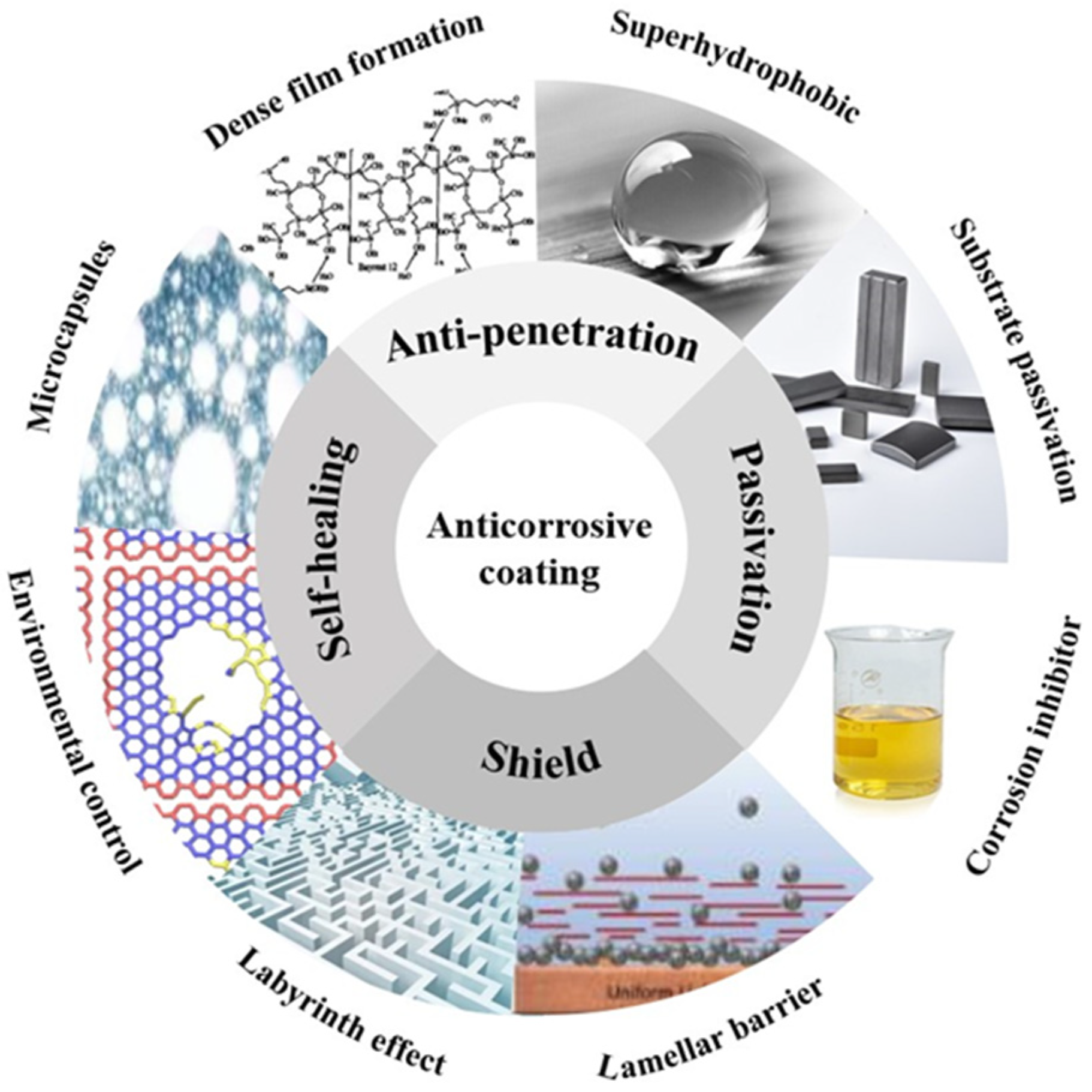
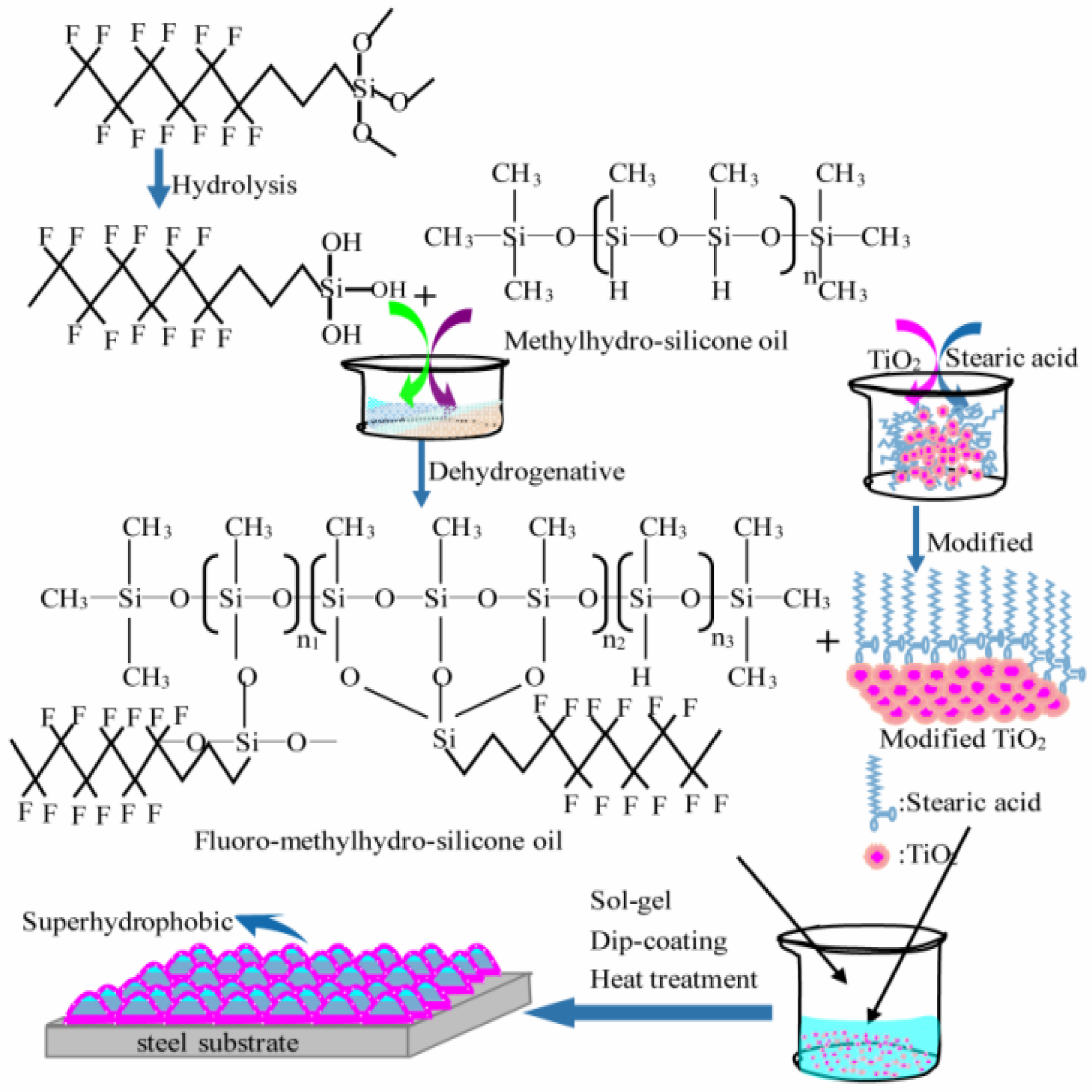
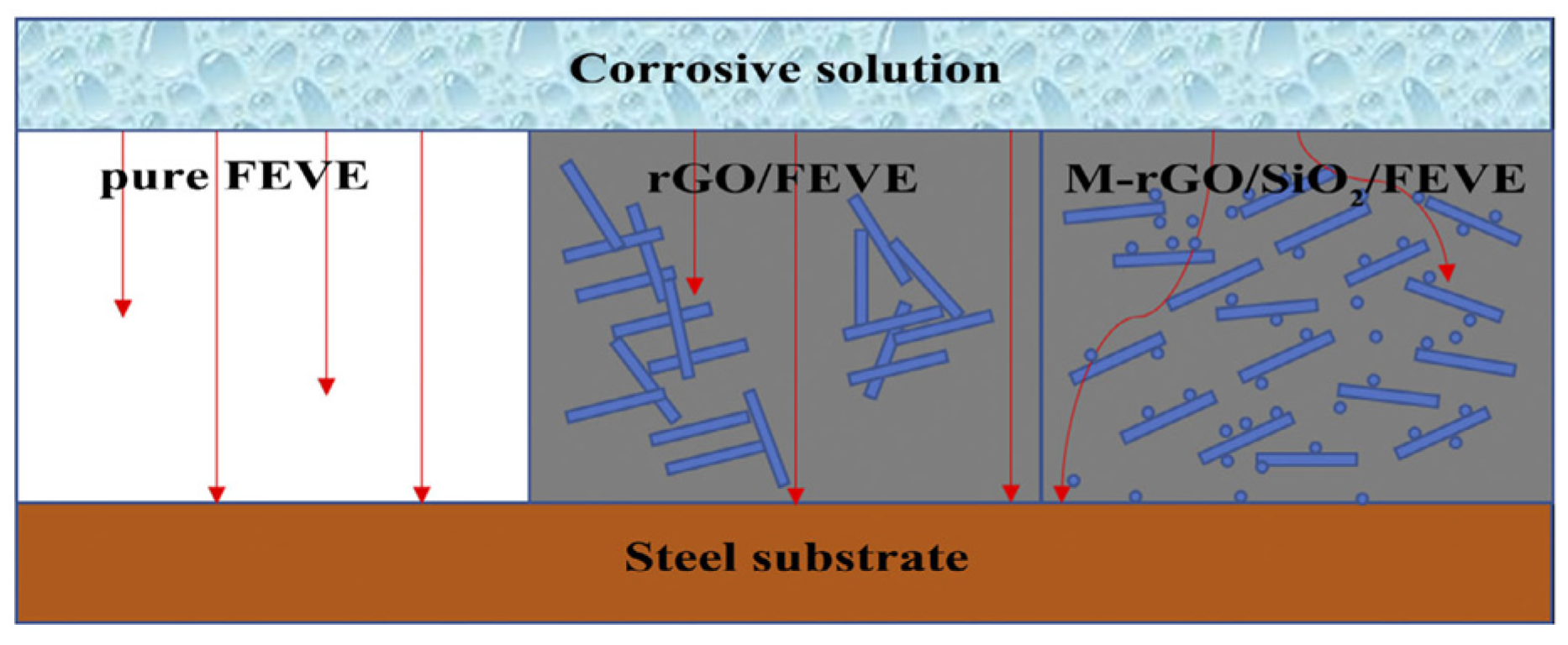
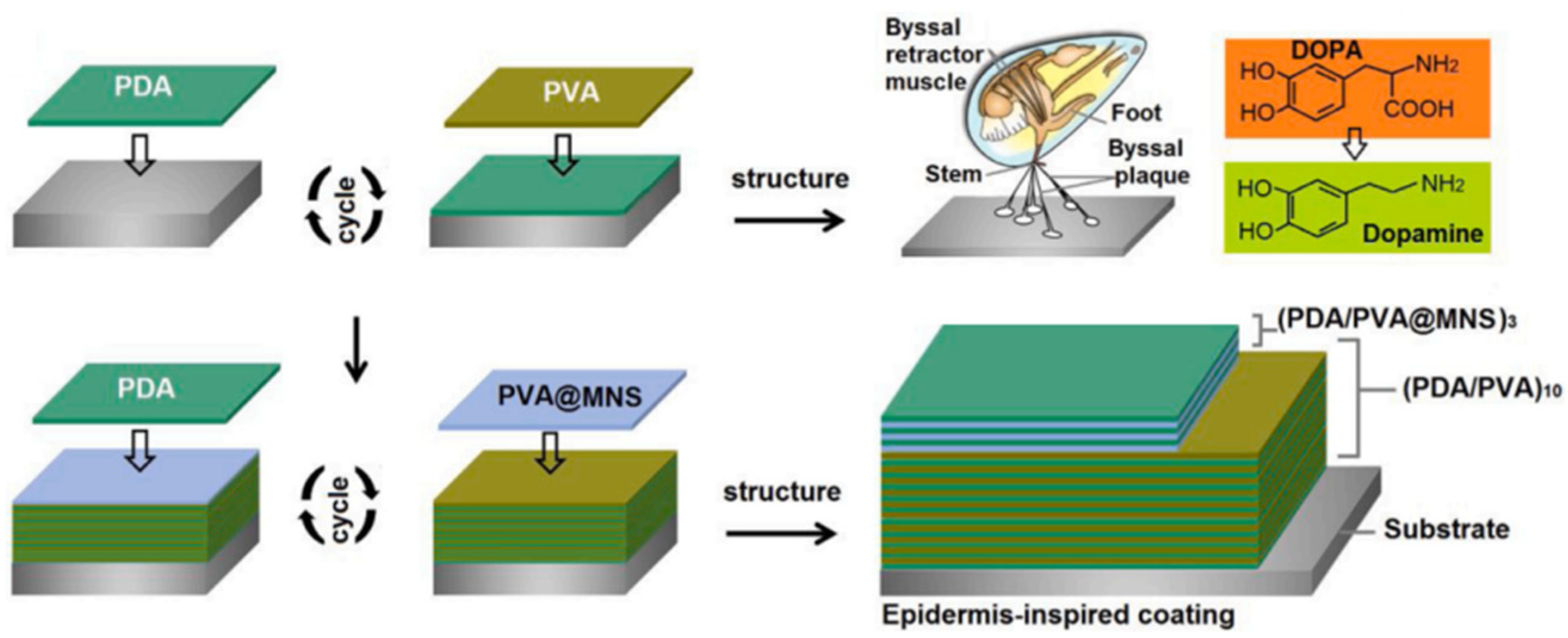
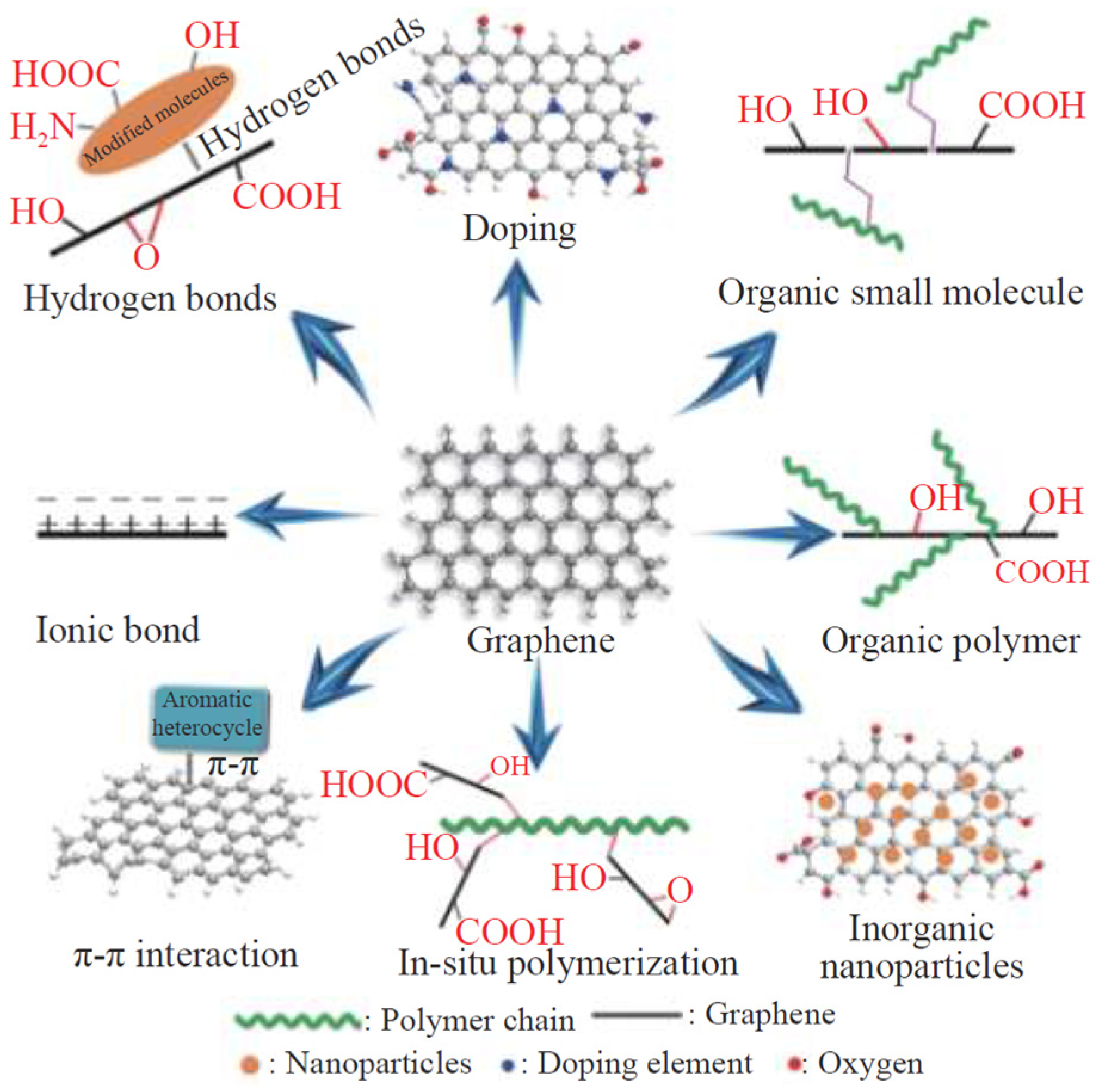
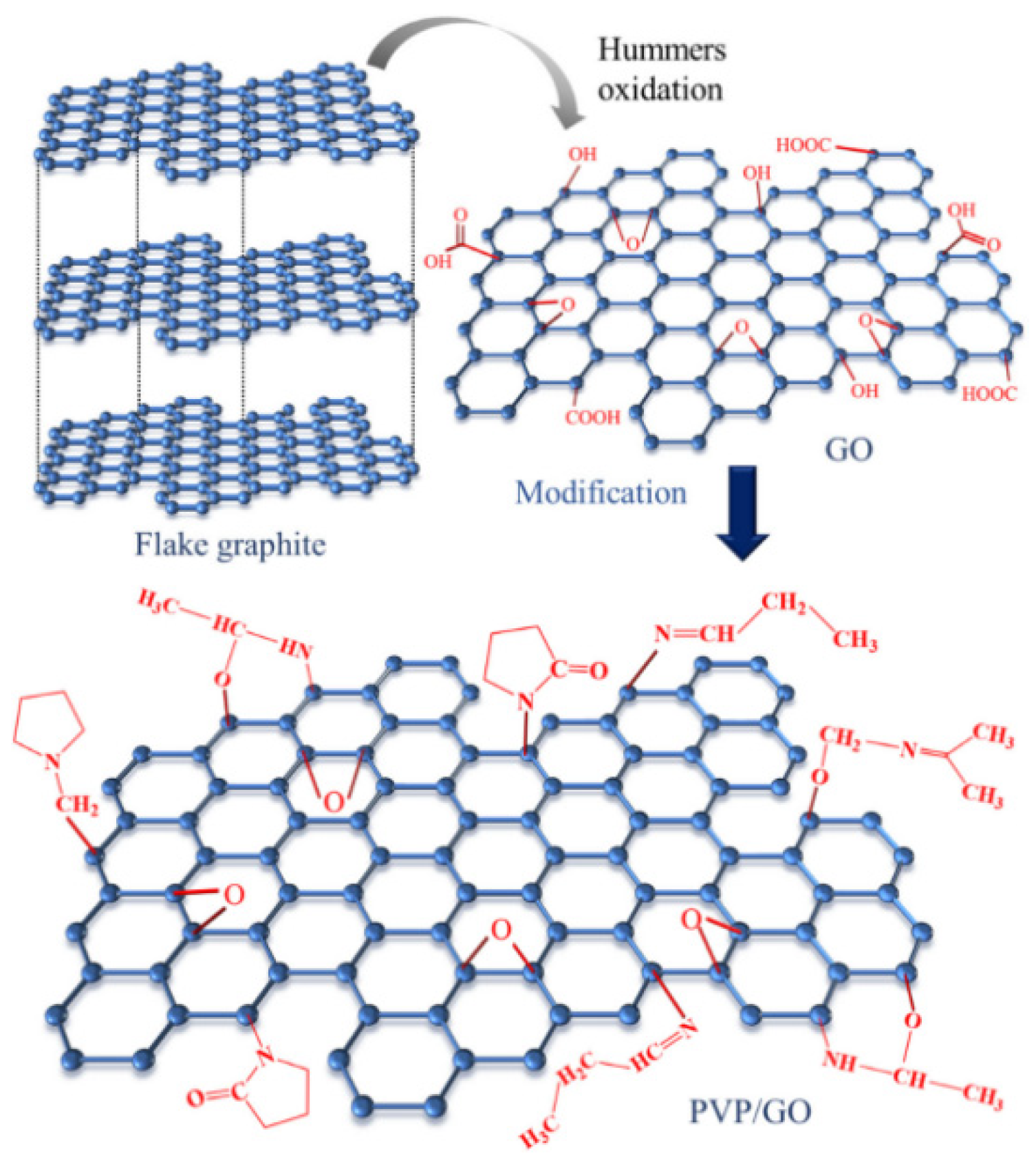
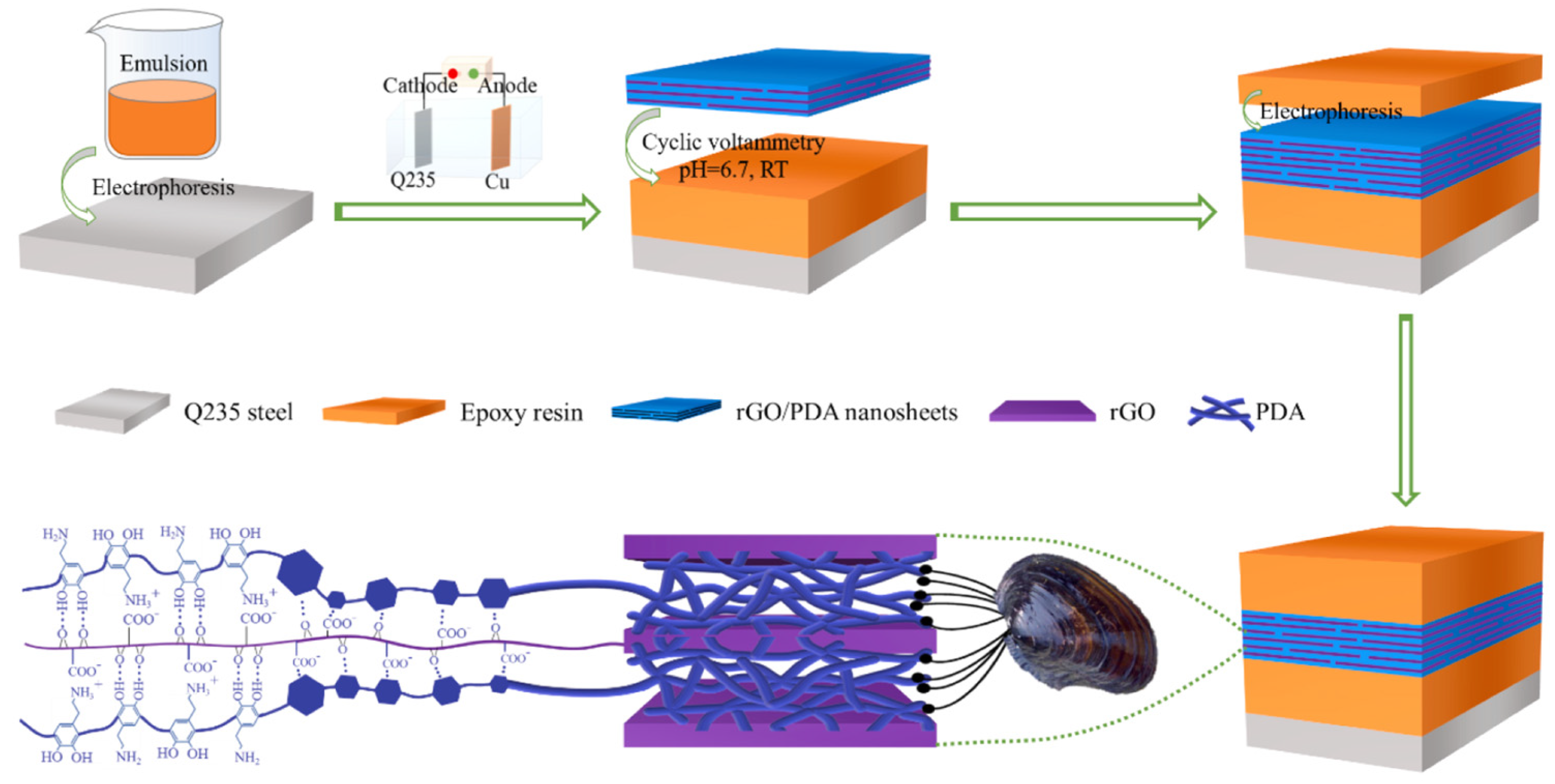


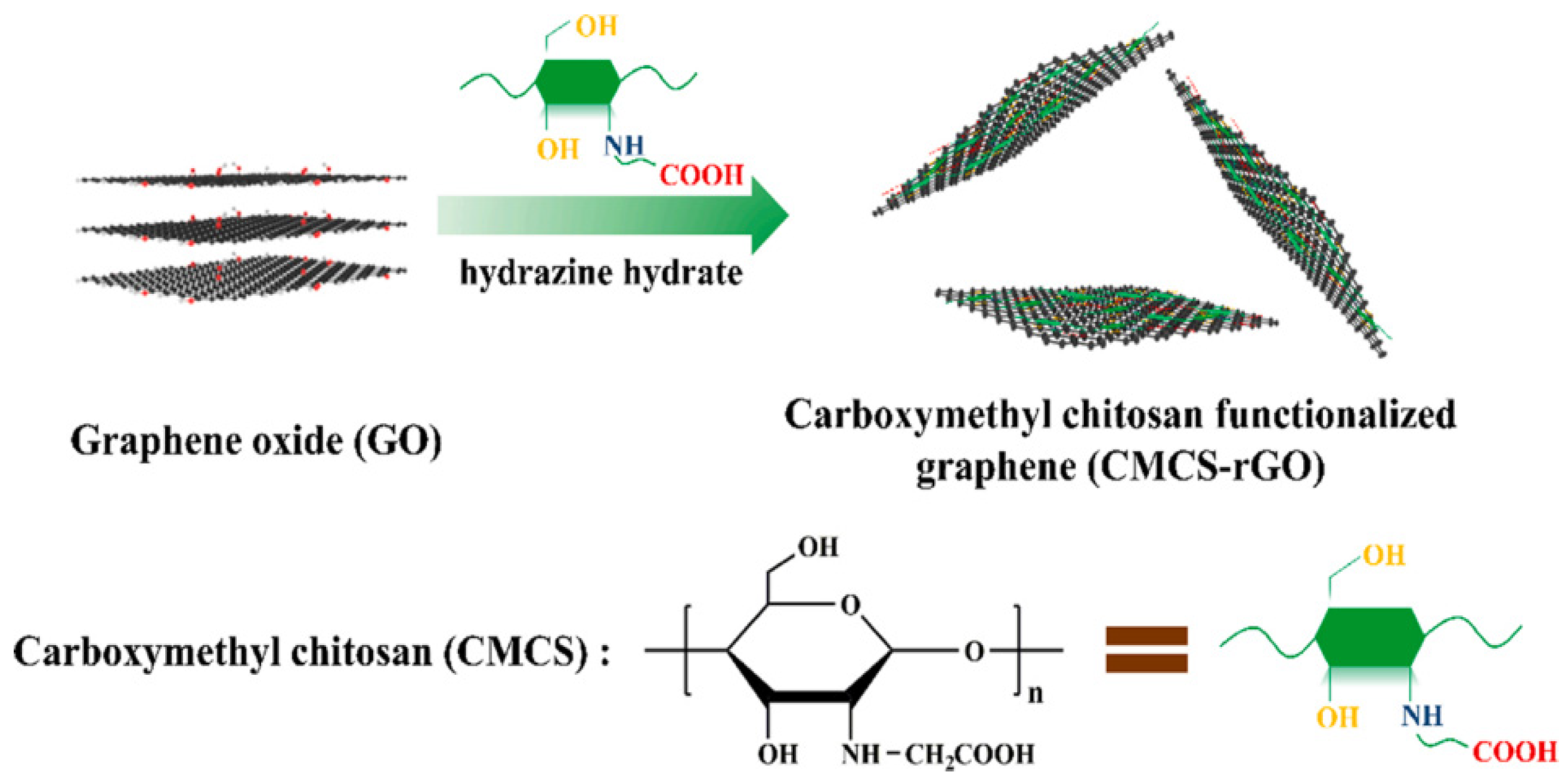
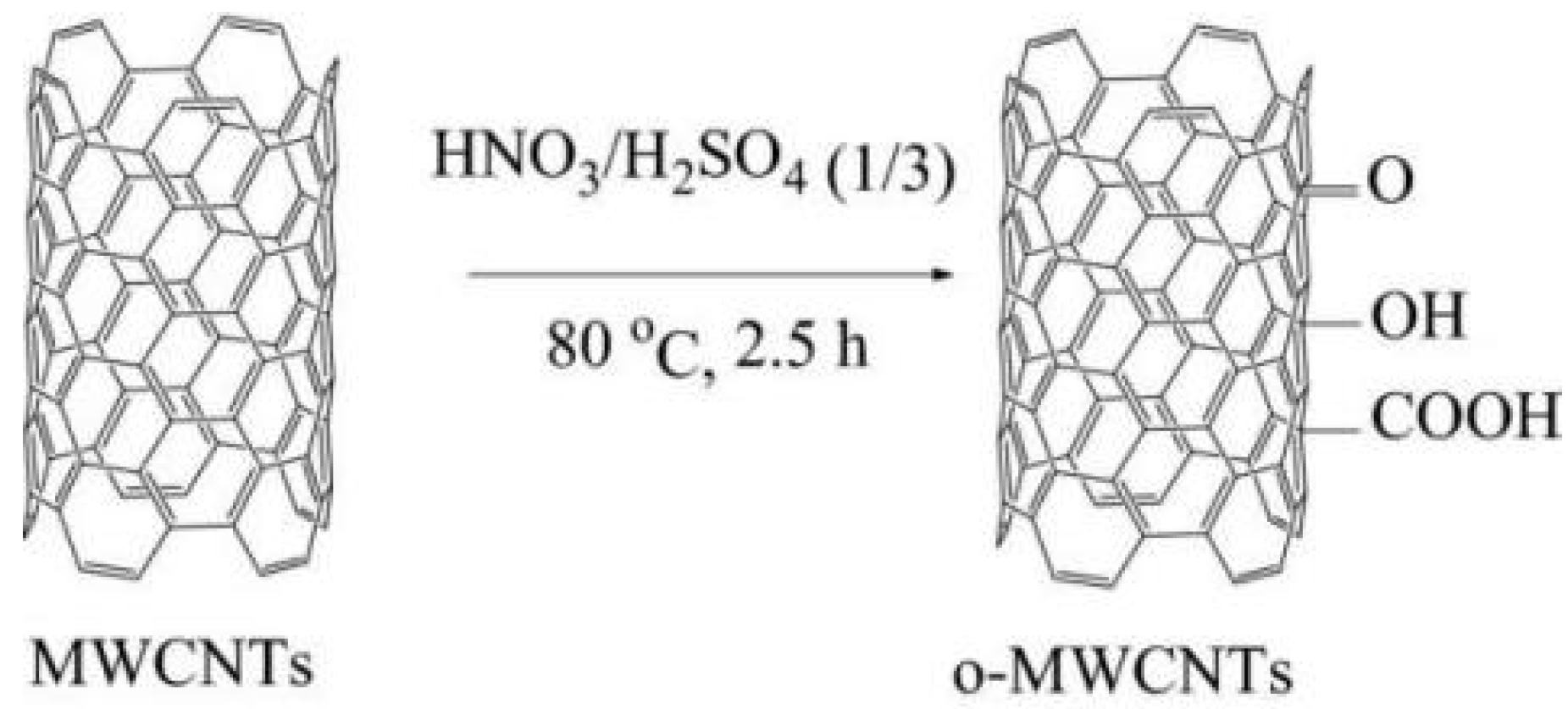


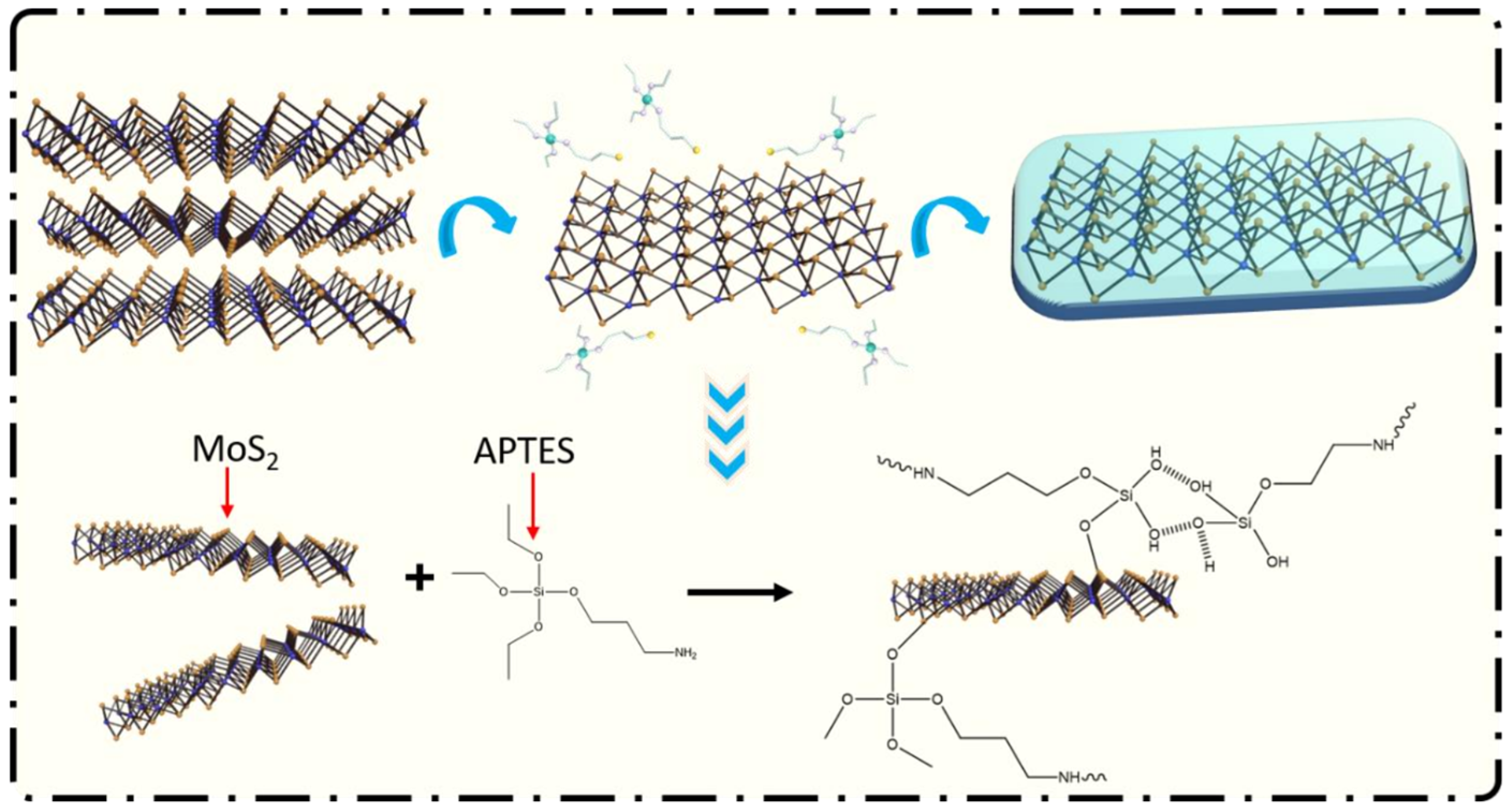
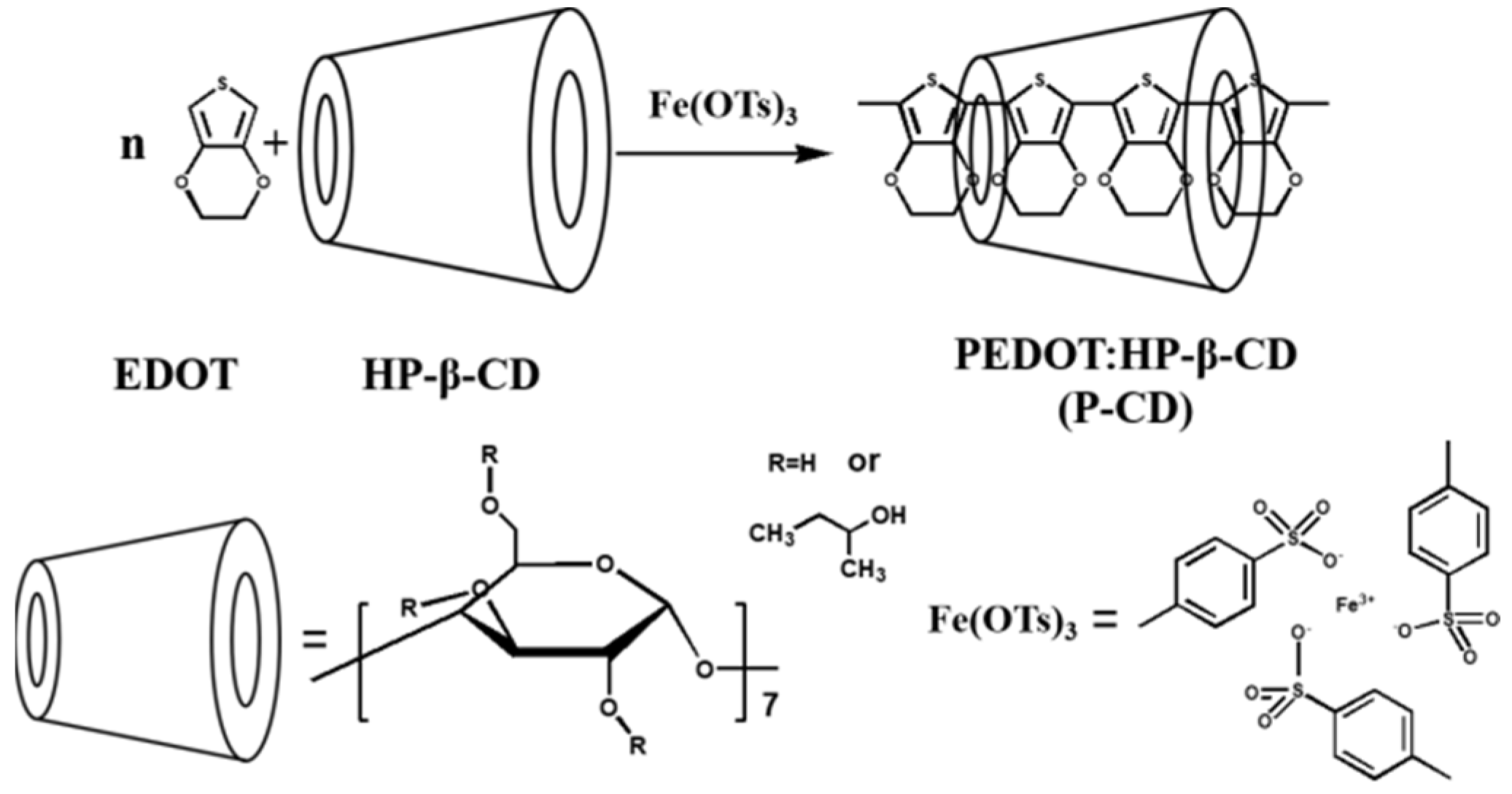
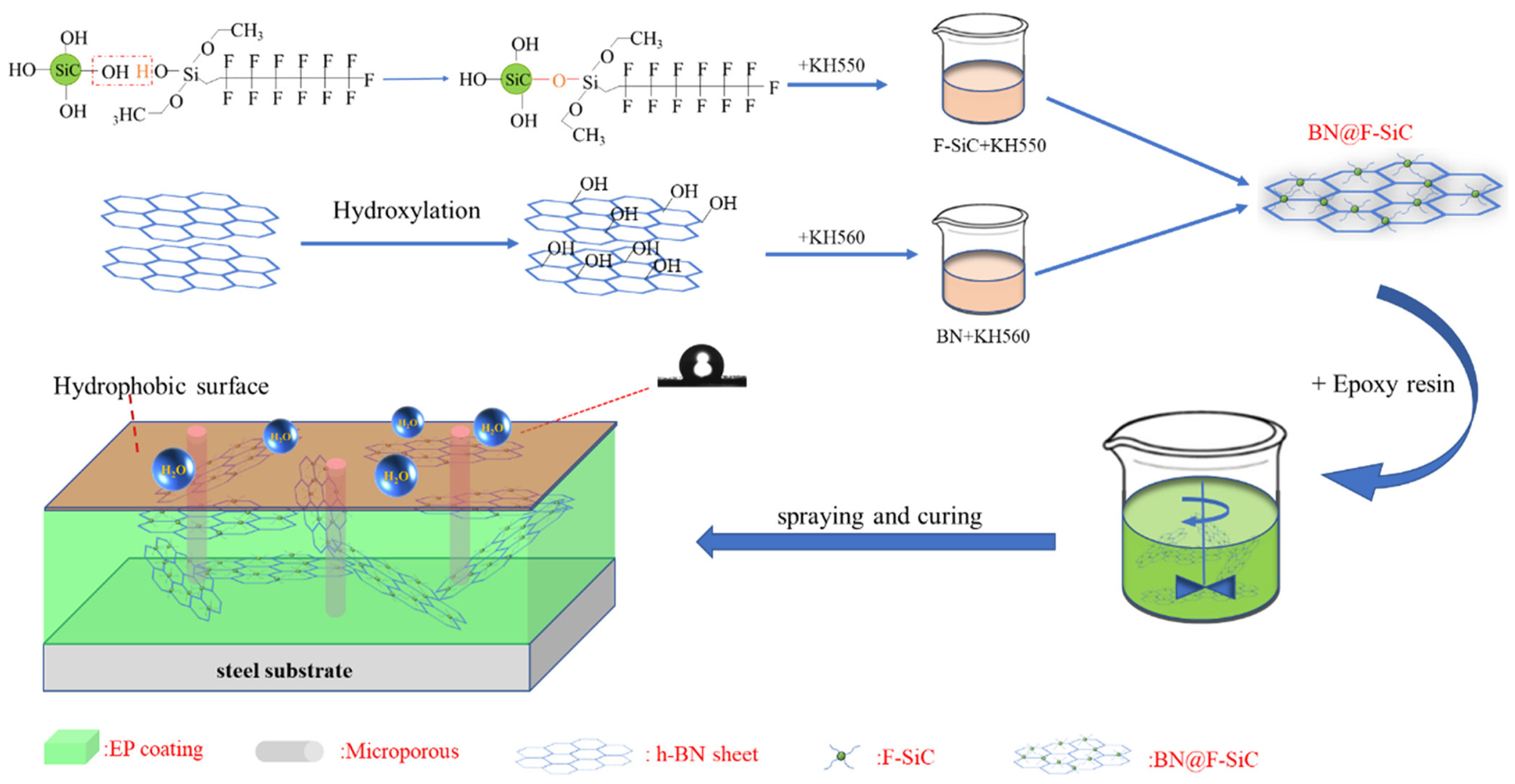

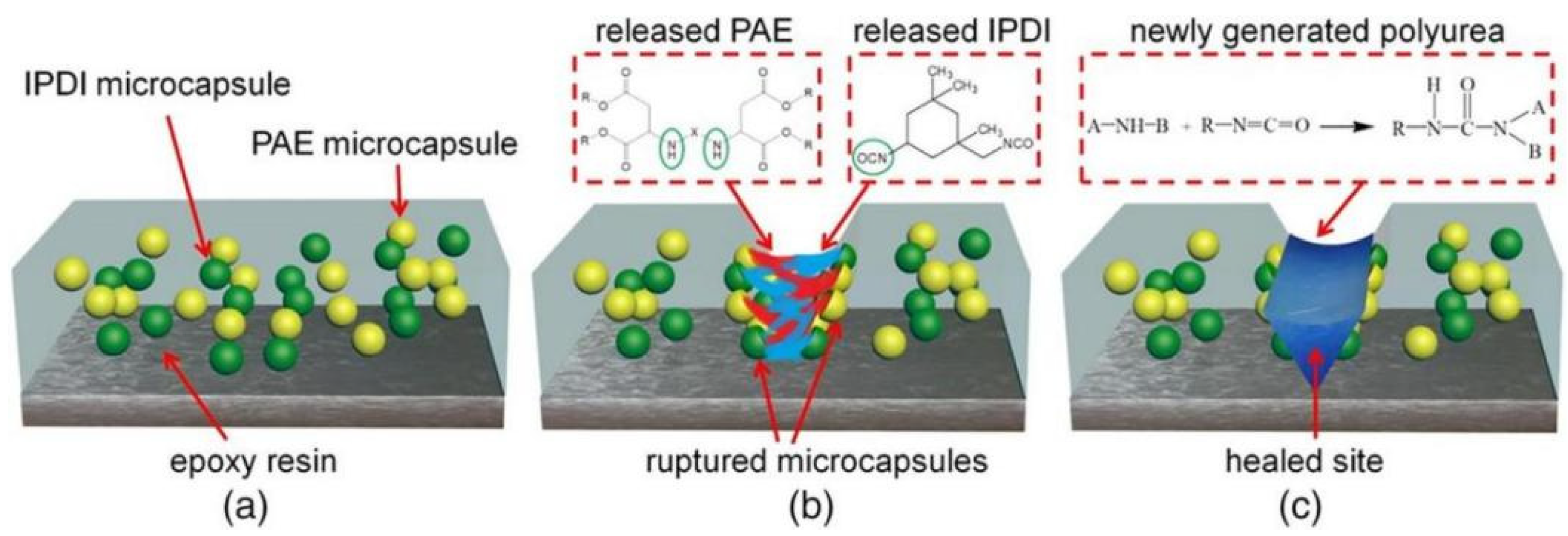
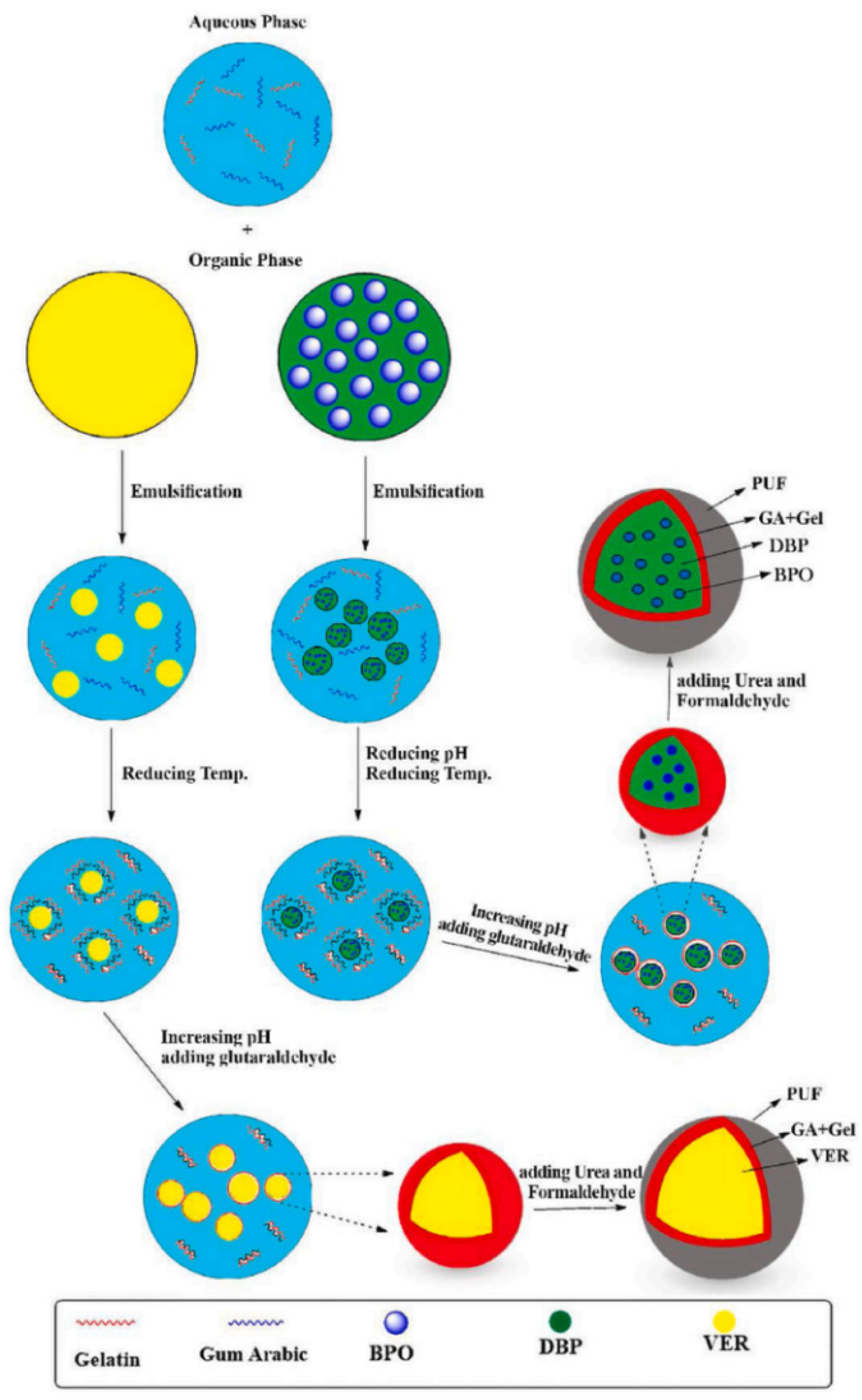
| Nanoparticles Modification | |||
|---|---|---|---|
| Category/Method | Materials | Category/Method | Materials |
| Silicon-based nanoparticles | SiC nanoparticle; Hydrophobic nano-SiO2 | Composite nanoparticle | Modified rGO-SiO2; Modified SiO2 and TiO2; ZnO; mica nanosheets; tannic acid-modified BN nanosheets |
| Titanium-based nanoparticles | PDMS-modified nano-TiO2; Stearic acid-modified TiO2 | ||
| Functionalized carbon-based materials | |||
| Category/Method | Materials | Category/Method | Materials |
| Graphene | PVP and GO; Dopamine-modified GO; Aminopropyltriethoxysilane modified rGO; [3-(2-aminoethyl) aminopropyl] trimethoxyl silane (KH792)-modified GO; Ionic liquid-modified GO; Carboxymethyl chitosan-functionalized rGO | Carbon nanotube | Oxidized multiwalled carbon nanotubes; Polyaniline-modified CNT; CNT/ polyindole |
| Specific functionalization | |||
| Category/Method | Materials | Category/Method | Materials |
| Prevent corrosion medium from penetrating | Neem seed oil-based alkyd resin; 3-aminopropyltriethoxysilane (APTES)-modified MoS2 | Substrate surface passivation | Polyaniline - Fe2O3; Polyaniline; Zinc-aluminum layered composite oxide |
| Shielding effect | Magnesium phosphate; PEDOT-hydroxypropyl-β-cyclodextrin | Improve resistivity | Benzoxazine; Functionalized SiC deposited BN |
| Self-repairing | Polyaniline plate; microencapsulated polyaspartate (PAE) and diisocyanate (IPDI) | ||
Disclaimer/Publisher’s Note: The statements, opinions and data contained in all publications are solely those of the individual author(s) and contributor(s) and not of MDPI and/or the editor(s). MDPI and/or the editor(s) disclaim responsibility for any injury to people or property resulting from any ideas, methods, instructions or products referred to in the content. |
© 2023 by the authors. Licensee MDPI, Basel, Switzerland. This article is an open access article distributed under the terms and conditions of the Creative Commons Attribution (CC BY) license (https://creativecommons.org/licenses/by/4.0/).
Share and Cite
Zhang, X.; Feng, Y.; Zhang, X.; Li, G.; Ma, Z.; Wang, X. A Review of Recent Modification, Optimization, and Functionalization Methods for Organic Anticorrosive Coatings. Coatings 2023, 13, 2019. https://doi.org/10.3390/coatings13122019
Zhang X, Feng Y, Zhang X, Li G, Ma Z, Wang X. A Review of Recent Modification, Optimization, and Functionalization Methods for Organic Anticorrosive Coatings. Coatings. 2023; 13(12):2019. https://doi.org/10.3390/coatings13122019
Chicago/Turabian StyleZhang, Xingjun, Yuee Feng, Xingyu Zhang, Gang Li, Zhengfeng Ma, and Xingwei Wang. 2023. "A Review of Recent Modification, Optimization, and Functionalization Methods for Organic Anticorrosive Coatings" Coatings 13, no. 12: 2019. https://doi.org/10.3390/coatings13122019




